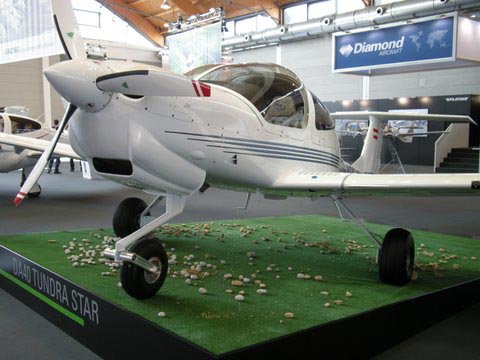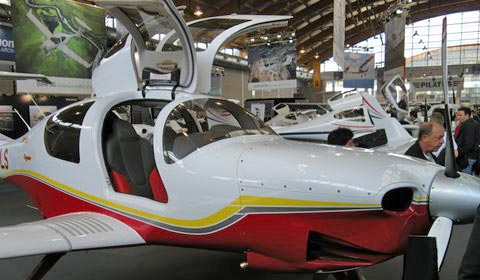
Diamond Aircraft has always had a big presence at the Aero show, and this year was no different. In spite of continuing economic angst in some quarters, Diamond keeps moving ahead. Heading the list of new developments was the unveiling of Diamond’s new DA40 TundraStar. The TundaStar—or simply “Tundra” as Diamond Chairman Christian Dries insisted—is essentially a DA40 with beefed-up landing gear, oversized tires, vortex generators and Fowler flaps. “This airplane is designed for the Russian market, but it will make a great trainer as well,” Dries said. “There are 16,000 grass strips in Russia, and the airspace is opening up in that country. But, many of those strips are very rough. To deal with this, we had to comply with Russian certification standards for landing on unimproved airports.”
The result is a tricycle landing gear able to withstand the stress of landings registering 20 Gs, Dries said. Russian rules meant complying with requirements asking to prove the ability to endure a specified number and depth of holes, ruts, and other irregularities within a horizontal distance of some 10 feet.

To keep stall speeds and takeoff and landing distances low (1,452 feet and 890 feet, respectively) the airplane’s wings are fitted with vortex generators, Fowler flaps, and winglets. To make the airplane easy to handle on the ground, the airplane has tricycle landing gear. The canopy has two prominent bulges that give front-seaters more shoulder- and headroom. As for cruise speed and range, Diamond says the Tundra will hit maximums of 143 KTAS and 640 nm (if equipped with long-range tanks). The panel includes Garmin G1000 avionics. Power comes from the FADEC-controlled, Jet A-burning, 168-hp AE300 Austro turbodiesel engine; the three-blade, constant-speed, composite propeller is by MT Propeller. Price of the Tundra is 220,000 euros, or about $318,000 at today’s exchange rates. “Many orders have been placed by Russian flight schools, and several more deposits were taken at Aero,” Dries said. The airplane is European Aviation Safety Agency (EASA) certified, and deliveries will begin shortly.
Another tundra-inspired Diamond on display was the HK36 Super Dimona, another tricycle-gear airplane with beefed up landing gear and big tires. Powered by your choice of a 100-hp Rotax 912 (the model TC 100) or a 115-hp Rotax 914 (the model TTC 115), the 119,000-euro ($166,000) airplane can cruise as fast as 102 knots and fly as far as 300 nm.
Diamond also showed off its newest engines in its Austro family of powerplants. The 280-hp AE500 topped the list, and this is the turbodiesel that will power Diamond’s 200-knot, 20,000-foot-ceiling DA50 Magnum—an airplane that Diamond put on hold several years ago for want of an acceptable engine. The AE500 will be so reliable that Diamond says its maintenance will most likely be “on condition,” meaning that regular inspections will replace recommended, fixed times between overhaul (TBOs). Two new rotary engines—one of 75 hp and another of 45 hp—were also displayed. These were developed for retrofit into airplanes in the Experimental category.




